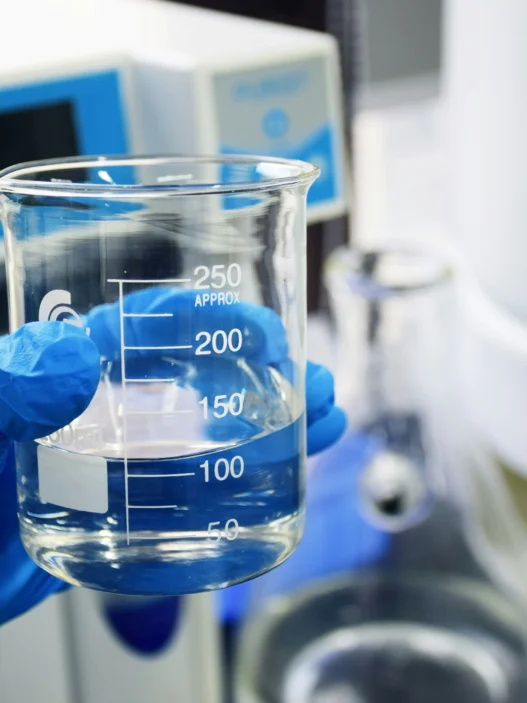Alpha-methylstyrene is a compound with various industrial applications, including its use as a monomer in the production of plastics, rubbers, and resins. These materials are integral to the manufacturing of everyday items such as packaging materials, adhesives, and household goods. Thus, alpha-methylstyrene plays a crucial role in the production of numerous consumer products that are essential to everyday life.
Table of Contents:
- 💡 Commercial Applications
- ⚗️ Chemical & Physical Properties
- 🏭 Production & Procurement
- ⚠️ Safety Considerations
- 🔬 Potential Research Directions
- 🧪 Related Compounds
💡 Commercial Applications
Alpha-Methylstyrene, a colorless liquid aromatic compound, finds diverse commercial and industrial applications. It is primarily used as a monomer in the production of polymers such as acrylonitrile-butadiene-styrene (ABS) and styrene-butadiene rubber (SBR). In addition, alpha-Methylstyrene serves as a solvent in various applications, including adhesives, coatings, and resins.
In the realm of drug and medication applications, alpha-Methylstyrene is not commonly utilized. Due to its chemical properties and potential toxicity, it is not suitable for pharmaceutical purposes. However, it is essential to note that this compound may be present as an impurity in certain medications, cautioning manufacturers to ensure its removal during the production process to adhere to regulatory standards and ensure product safety.
⚗️ Chemical & Physical Properties
Alpha-Methylstyrene is a colorless liquid with a strong, characteristic smell. It is commonly used in the production of plastics and resins due to its unique chemical properties.
The molar mass of alpha-Methylstyrene is approximately 120.18 g/mol, and its density is around 0.905 g/cm3. In comparison to common food items, alpha-Methylstyrene has a higher molar mass and lower density than water and most food products.
Alpha-Methylstyrene has a melting point of around -24°C and a boiling point of approximately 163°C. These values are higher than those of most common food items, which typically have melting points and boiling points closer to room temperature.
Alpha-Methylstyrene is not soluble in water but is soluble in organic solvents. It has a relatively low viscosity compared to many common food items, which may be more viscous or sticky in nature.
🏭 Production & Procurement
Alpha-Methylstyrene is typically produced through the catalytic dehydrogenation of cumene. This process involves the reaction of cumene with oxygen at high temperatures, producing alpha-Methylstyrene as a byproduct.
Once alpha-Methylstyrene is produced, it can be procured from a variety of chemical suppliers or manufacturers. The compound is commonly transported in bulk by tanker trucks or railcars to distribution centers for further processing or integration into other products.
In terms of transportation, alpha-Methylstyrene is often shipped in liquid form in specialized containers that are designed to handle the chemical safely. The compound is classified as a hazardous material, requiring strict adherence to regulatory standards for handling and transport.
⚠️ Safety Considerations
Safety considerations for alpha-Methylstyrene should be taken seriously due to its potential hazards. When handling this chemical, it is important to wear appropriate personal protective equipment, such as gloves and goggles, to prevent skin contact and eye irritation. Adequate ventilation should be provided in work areas where alpha-Methylstyrene is being used to reduce the risk of inhalation exposure. Additionally, storage of this chemical should be in a cool, dry, well-ventilated area away from incompatible substances to prevent accidents or reactions.
Hazard statements for alpha-Methylstyrene include “Causes skin irritation” and “May cause an allergic skin reaction.” These statements indicate the potential dangers associated with skin contact with the chemical, which can result in irritation and allergic reactions. In addition, alpha-Methylstyrene is classified as a flammable liquid and vapor, with the hazard statement “Flammable liquid and vapor.” This means that the chemical poses a fire hazard and should be stored and handled with caution to prevent accidents.
Precautionary statements for alpha-Methylstyrene recommend using the chemical in a well-ventilated area and avoiding breathing vapors to minimize inhalation exposure. It is also advised to wear protective gloves and clothing when handling alpha-Methylstyrene to prevent skin contact. In case of skin contact, immediate action should be taken to wash the affected area with soap and water. Furthermore, precautions should be taken to prevent the release of alpha-Methylstyrene into the environment, as it can be harmful to aquatic life. Proper disposal methods should be followed to ensure the safety of both humans and the environment.
🔬 Potential Research Directions
One potential research direction for alpha-Methylstyrene involves exploring its applications as a monomer in the production of specialty polymers with unique properties. Such research could investigate the synthesis, characterization, and performance of alpha-Methylstyrene-based polymers in various industrial applications.
Another research avenue could focus on the development of novel catalytic processes for the efficient production of alpha-Methylstyrene, aiming to enhance the overall yield and selectivity of the desired product. This research direction could involve examining different catalytic systems, reaction conditions, and process optimization strategies to improve the commercial viability of alpha-Methylstyrene synthesis.
Further research into the environmental and health implications of alpha-Methylstyrene exposure may also be warranted, with studies exploring its potential toxicological effects, environmental fate, and occupational health risks. This research direction could provide valuable insights into the safe handling and disposal of alpha-Methylstyrene and its derivatives, facilitating regulatory decisions and risk management strategies.
🧪 Related Compounds
One similar compound to alpha-Methylstyrene is p-Methylstyrene. This compound has a methyl group attached to the para position of the phenyl ring, similar to alpha-Methylstyrene. The presence of the methyl group at this location affects the chemical and physical properties of p-Methylstyrene, making it a comparable compound to alpha-Methylstyrene.
Another compound that shares structural similarities with alpha-Methylstyrene is p-Ethylstyrene. In this compound, an ethyl group is attached to the para position of the phenyl ring, reminiscent of the methyl group in alpha-Methylstyrene. The presence of the ethyl group in p-Ethylstyrene imparts distinct properties to the compound, which may be of interest for various industrial applications.
One more comparable compound to alpha-Methylstyrene is m-Methylstyrene. In this compound, the methyl group is attached to the meta position of the phenyl ring, resulting in a different molecular structure compared to alpha-Methylstyrene. Despite this difference, m-Methylstyrene exhibits some similar chemical and physical properties to alpha-Methylstyrene, making it a relevant compound for comparison and analysis.





